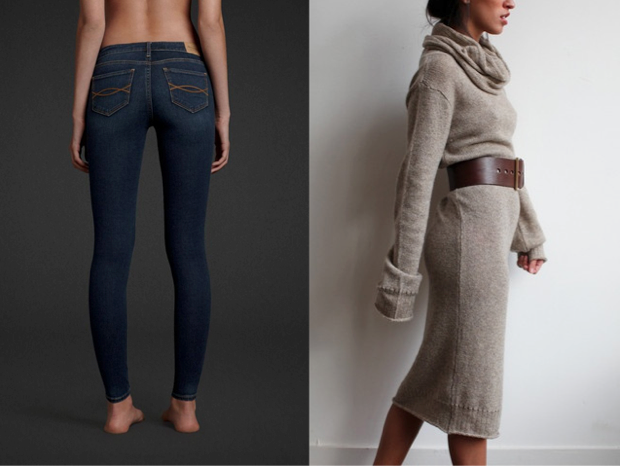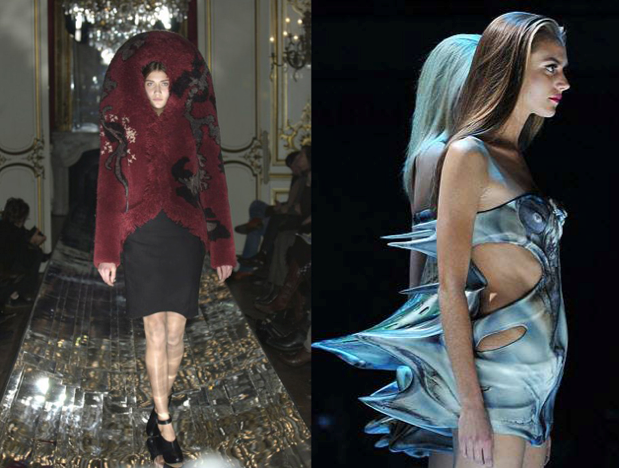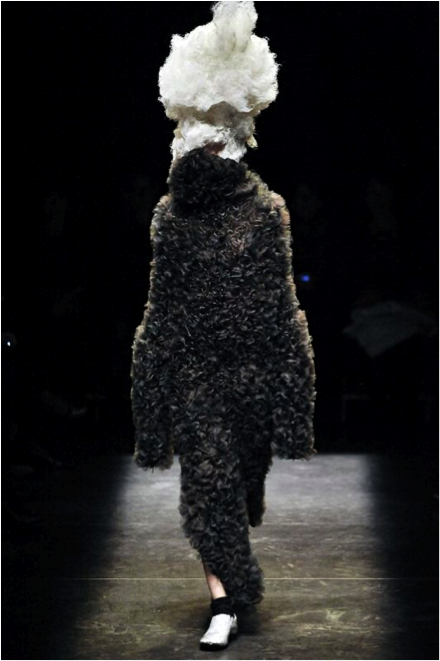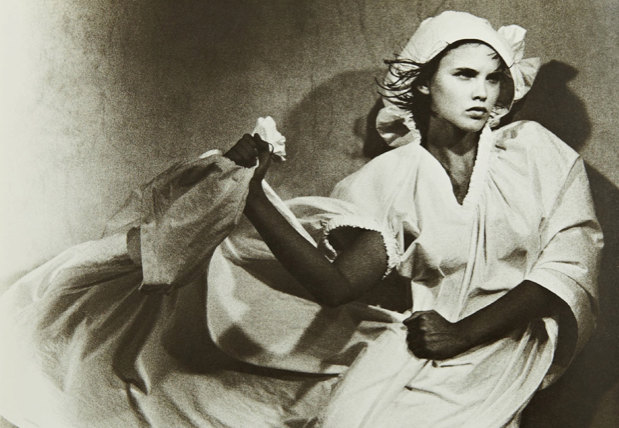THE CLOTHING INDUSTRY has recently seen the introduction of new garments which fall outside of existing definitions. These innovations bring with them requirements for new terminology to distinguish new from old, reminding us of the power of linguistics in the design process. Garments including ‘jeggings’ and the ‘jumper dress’ are unlike previously existing objects, but in order to unambiguously express the purpose and features of such clothing, designers have defined them in pre-existing terms. In contrast, avant-garde designers like Rei Kawakubo, Hussein Chalayan and others of this ilk work with more freedom in the high end of the fashion system, and their designs defy the trappings of pre-existing semantics.
The term ‘jeggings’ – a blend of ‘jeans’ and ‘leggings’ – expresses both familiarity and difference. It provides the reassurance of two familiar and much-loved items – jeans and leggings – combined with the promise of something new and unique. While the fashion cycle thrives on newness, such compound terms reflect the difficulties that designers have with the concept of a garment that is entirely new.

It is not just compound terms that are problematic, but the need to define all garments using existing language. When we define any garment with pre-existing terms, its name prompts certain assumptions about its design. This limits opportunities to step outside these strictly defined boundaries, and hence restricts opportunities for creativity.
A blouse, for example, has established design features and methods of wearing. Even if we are not using the term to refer to any specific item, ‘blouse’ as a concept is surprisingly specific. It has standards features that are taken for granted, such as a collar and buttons. The term also has cultural connotations, being both gendered and, increasingly, formal in contrast to new and more casual alternatives. By merely labelling a blouse as such, we dictate its form and its use. In this way, terminology determines our perception of, and response to, a garment.
Austrian philosopher Ludwig Wittgenstein introduced the notion of ‘linguistic determinism’, proposing that language limits or determines our perception of objects. If, as theories of linguistic determinism suggest, ‘the presence of linguistic categories creates cognitive categories’,1 it is difficult to imagine garments that do not conform to any pre-existing definition. Terms for common garments, such as ‘dress’, ‘coat’, ‘blouse’, evoke preconceived ideas about the form and function of each.
These common terms appear in mass-market fashion since, for high-street and online retailers, it is necessary to catalogue and define the garments that they stock. Any process of cataloguing requires categories, and when those categories are binary or mutually exclusive, there is no allowance for anything that falls outside of existing definitions.
In high fashion, there are fewer requirements to categorise or define garments. This permits freedom to design outside of pre-existing terms and categories. Hussein Chalayan, for example, has presented designs that extended so far ‘outside the traditional confines of fashion’, that they are difficult to define.2 Though Chalayan defined many of his earlier garments in descriptive terms (such as the ‘aeroplane dress’, 1999), his later collections are identified according to concept or theme, thereby avoiding the need to offer a practical description that would potentially have a limiting affect on audiences’ perception of his work.

Rei Kawakubo’s first internationally received collections for Comme des Garçons ‘questioned the logic of clothing itself’.3 Kawakubo succeeds in innovating because she avoids the trap of linguistic determinism. She aims to ‘design clothes that have never existed,’ beginning with no assumptions about the form that each garment will take, and refuses to categorise her works according to form or function. ‘I decided to start from zero,’ she tells The New York Times, ‘from nothing, to things that have not been done before.’4

By refusing to dictate the nature or wearing of a garment, Kawakubo offers freedom of interpretation. She is, in literary theorist Roland Barthes’ terms, a ‘scriptor’ rather than sole creator of each garment, allowing the meaning of the garment to be ‘externally written’.5 She proposes a form, offering it up for interpretation, and making no pronouncements about the validity of each response.
Kawakubo’s resistance to definition extends even to the component parts of each garment. In the ‘Wrapped Collection’ (1983) garments were wrapped and draped, with ‘flaps and appendages that could be tied…in a variety of ways so that each garment permitted a multiplicity of wearings’. The later ‘Elastic Collection’ (1986) contained a number of elasticated holes. It was up to the wearer to decide which hole to use for which appendage, and where to position the spare holes, which would reveal another layer beneath.6

Commentators have struggled to describe many of the garments produced by Chalayan, Comme des Garçons’, and their contemporaries. The New York-based Fashion Institute of Technology museum describes Kawakubo’s work as ‘indefinable’.7 This indefinability is praised as innovation, and is largely a consequence of working outside of the confines of pre-existing terms and ideas about the nature of clothes.
Barbara Brownie is a researcher and writer. She is also lecturer in fashion history and theory at the University of Hertfordshire.
D Carroll, Psychology of Language, 5th Edition, Thompson Wadsworth, Belmont: CA, 2008, p. 401. ↩
G Ashkenazi, as cited in ‘Hussein Chalayan Named Designer of Vionnet Demi-Couture Collection,’ Chalayan.com, 6 January 2014, http://chalayan.com/blog/ ↩
C Evans and M Thornton, ‘Fashion, Representation, Femininity,’ Feminist Review, No. 38 (1991), 61. ↩
R Kawakubo, interviewed in The New York Times, 1982, as cited in MOCAD (Museum of Contemporary Art Detroit), ReFusing Fashion: Rei Kawakubo, 2008. http://www.mocadetroit.org/exhibitions/comme.html ↩
R Barthes, ‘The Death of the Author’, 1968, reproduced in Image Music Text, Fontana Press, London, 1977. ↩
C Evans and M Thornton, ‘Fashion, Representation, Femininity,’ Feminist Review, No. 38 (1991), 61. ↩
The Museum at FIT, Rei Kawakubo bio, http://fashionmuseum.fitnyc.edu/view/people/asitem/items$0040:4217/0;jsessionid=4B2409EDAFFE52693C3C282E6588DC53?t:state:flow=cf9ca084-b030-4756-9a00-1498ac5335a2 ↩